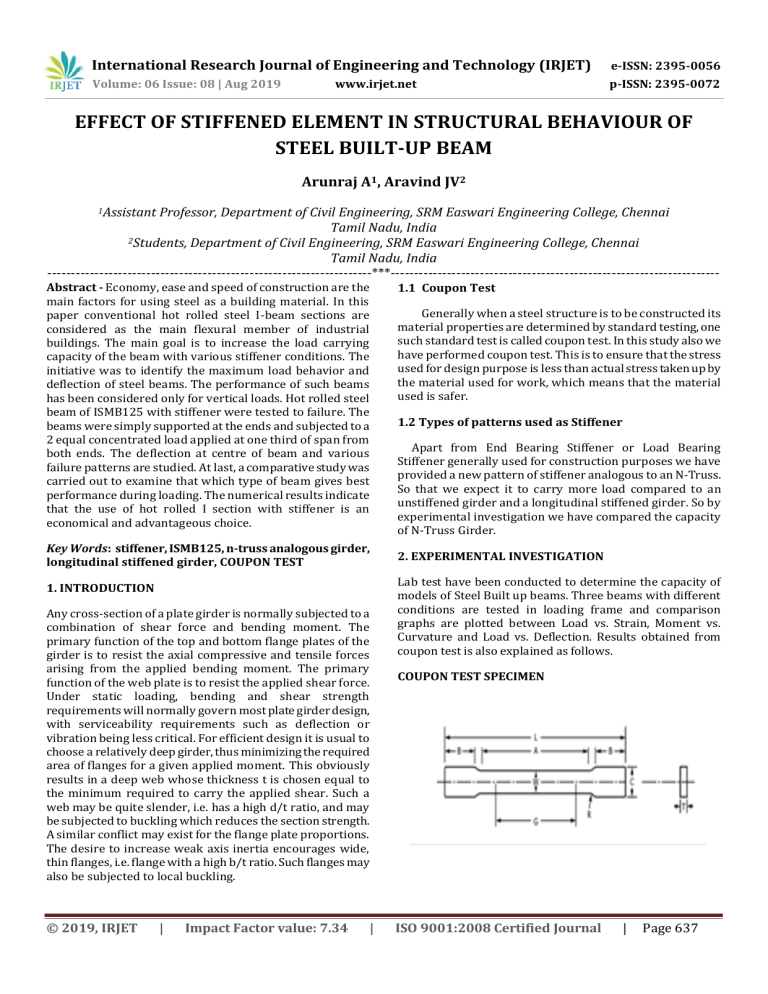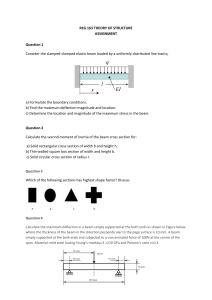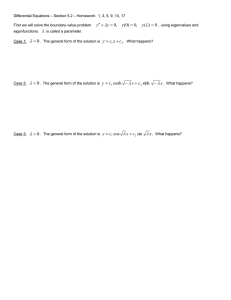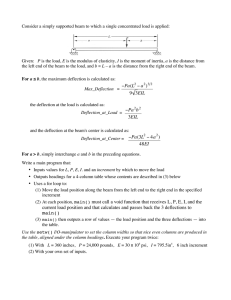IRJET- Effect of Stiffened Element in Structural Behaviour of Steel Built-Up Beam
advertisement

International Research Journal of Engineering and Technology (IRJET) e-ISSN: 2395-0056 Volume: 06 Issue: 08 | Aug 2019 p-ISSN: 2395-0072 www.irjet.net EFFECT OF STIFFENED ELEMENT IN STRUCTURAL BEHAVIOUR OF STEEL BUILT-UP BEAM Arunraj A1, Aravind JV2 1Assistant Professor, Department of Civil Engineering, SRM Easwari Engineering College, Chennai Tamil Nadu, India 2Students, Department of Civil Engineering, SRM Easwari Engineering College, Chennai Tamil Nadu, India ---------------------------------------------------------------------***---------------------------------------------------------------------Abstract - Economy, ease and speed of construction are the main factors for using steel as a building material. In this paper conventional hot rolled steel I-beam sections are considered as the main flexural member of industrial buildings. The main goal is to increase the load carrying capacity of the beam with various stiffener conditions. The initiative was to identify the maximum load behavior and deflection of steel beams. The performance of such beams has been considered only for vertical loads. Hot rolled steel beam of ISMB125 with stiffener were tested to failure. The beams were simply supported at the ends and subjected to a 2 equal concentrated load applied at one third of span from both ends. The deflection at centre of beam and various failure patterns are studied. At last, a comparative study was carried out to examine that which type of beam gives best performance during loading. The numerical results indicate that the use of hot rolled I section with stiffener is an economical and advantageous choice. Key Words: stiffener, ISMB125, n-truss analogous girder, longitudinal stiffened girder, COUPON TEST 1. INTRODUCTION Any cross-section of a plate girder is normally subjected to a combination of shear force and bending moment. The primary function of the top and bottom flange plates of the girder is to resist the axial compressive and tensile forces arising from the applied bending moment. The primary function of the web plate is to resist the applied shear force. Under static loading, bending and shear strength requirements will normally govern most plate girder design, with serviceability requirements such as deflection or vibration being less critical. For efficient design it is usual to choose a relatively deep girder, thus minimizing the required area of flanges for a given applied moment. This obviously results in a deep web whose thickness t is chosen equal to the minimum required to carry the applied shear. Such a web may be quite slender, i.e. has a high d/t ratio, and may be subjected to buckling which reduces the section strength. A similar conflict may exist for the flange plate proportions. The desire to increase weak axis inertia encourages wide, thin flanges, i.e. flange with a high b/t ratio. Such flanges may also be subjected to local buckling. © 2019, IRJET | Impact Factor value: 7.34 | 1.1 Coupon Test Generally when a steel structure is to be constructed its material properties are determined by standard testing, one such standard test is called coupon test. In this study also we have performed coupon test. This is to ensure that the stress used for design purpose is less than actual stress taken up by the material used for work, which means that the material used is safer. 1.2 Types of patterns used as Stiffener Apart from End Bearing Stiffener or Load Bearing Stiffener generally used for construction purposes we have provided a new pattern of stiffener analogous to an N-Truss. So that we expect it to carry more load compared to an unstiffened girder and a longitudinal stiffened girder. So by experimental investigation we have compared the capacity of N-Truss Girder. 2. EXPERIMENTAL INVESTIGATION Lab test have been conducted to determine the capacity of models of Steel Built up beams. Three beams with different conditions are tested in loading frame and comparison graphs are plotted between Load vs. Strain, Moment vs. Curvature and Load vs. Deflection. Results obtained from coupon test is also explained as follows. COUPON TEST SPECIMEN ISO 9001:2008 Certified Journal | Page 637 International Research Journal of Engineering and Technology (IRJET) e-ISSN: 2395-0056 Volume: 06 Issue: 08 | Aug 2019 p-ISSN: 2395-0072 www.irjet.net Fig 1: Before and after testing Chart -1: Load vs. Strain Coupon Test Table -1: Coupon Test EXPERIMENTAL RESULTS OF BEAMS BEAM WITHOUT STIFFENER: LOAD (KN) VERTICAL STRAIN HORIZONTAL STRAIN 0 0 0 5 0.000031 0.000007 10 0.000052 0.000012 15 0.00008 0.000022 20 0.000106 0.00003 25 0.000131 0.000034 30 0.00015 0.000042 35 0.000185 0.000048 40 0.0002 0.000056 45 0.000235 0.000063 50 0.000258 0.000075 55 0.000299 0.000089 60 0.000323 0.000105 65 0.000361 0.000115 70 0.000393 0.000132 Fig 2: Before and after testing un-stiffened beam 75 0.000448 0.000146 Table -2: BEHAVIOUR OF BEAM W ITHOUT STIFFENER 80 0.000489 0.00021 85 0.00095 0.000355 90 0.00169 0.00048 From the graph in Chart-1 it is evident that Yield Stress of specimen used for testing is obtained at a load of 81kN which is 337.5MPa. This states that material can withstand 337.5MPa but we have considered only 250MPa Design stress which is very safe for design. We have underestimated the design stress for a Factor of Safety of about 1.35ensuring more safety. © 2019, IRJET | Impact Factor value: 7.34 | LOA D (KN) Central deflection (mm) Compres sion strain Tensio n strain Momen t (KNm) Cur vatu re 0 0 0 0 0 0 10 0.8 -0.00004 0.000 02 1.669 32.1 564 20 1.65 -0.00011 0.000 04 2.332 80.9 019 3.5 125. 854 5 30 2.69 -0.00014 0.000 1 40 3.74 -0.00014 0.000 155 4.669 196. 578 50 4.63 -0.00028 0.000 5.864 220. ISO 9001:2008 Certified Journal | Page 638 International Research Journal of Engineering and Technology (IRJET) e-ISSN: 2395-0056 Volume: 06 Issue: 08 | Aug 2019 p-ISSN: 2395-0072 www.irjet.net 244 60 5.03 -0.00023 0.000 308 7.023 245. 777 70 5.21 -0.00026 0.000 342 8.205 260. 548 5.69 0.00029 6 0.000 359 9.332 284. 862 6.25 0.00033 3 0.000 41 10.498 301. 562 80 90 Chart -4: Moment vs. Curvature Un-stiffened Beam 522 Chart -2: Load vs. Strain Un-stiffened Beam From Load Vs Deflection curve it is evident that Central deflections for corresponding Load is very high compared to deflection at L/3 points. This moment curvature curve indicates the nominal behavior of a Plane un stiffened beam. Load vs. strain curve suggests that tension strain is more in this case compared to compression strain. BEAM WITH LONGITUDINAL STIFFENER: Chart -3: Load vs. Deflection Un-stiffened Beam Fig 3: Before and after testing Longitudinal stiffened beam Table -3:BEHAVIOUR OF LONGITUDINAL STIFFENED BEAM © 2019, IRJET | Impact Factor value: 7.34 | LOA D (KN) Central deflection (mm) Compres sion strain Tensio n strain Momen t (KNm) Cur vatu re 0 0 0 0 0 0 10 0.59 -0.00001 0.000 1.165 38.1 ISO 9001:2008 Certified Journal | Page 639 International Research Journal of Engineering and Technology (IRJET) e-ISSN: 2395-0056 Volume: 06 Issue: 08 | Aug 2019 p-ISSN: 2395-0072 www.irjet.net 017 Chart -7: Moment vs. Curvature Un-stiffened Beam 202 20 1.22 -0.00003 0.000 062 2.32 81.6 512 30 1.79 -0.00005 0.000 079 3.26 126. 485 40 2.43 -0.00012 0.000 112 4.59 164. 596 50 3.11 -0.00013 0.000 133 5.45 214. 485 60 3.59 -0.00016 0.000 155 7 265. 154 70 4.22 -0.00018 0.000 16 8.62 304. 140 80 5 -0.00021 0.000 179 9.25 325. 145 90 5.49 -0.00024 0.000 209 10.45 336. 151 From Chart 6 Load Vs Deflection curve shows that deflection at L/3 point is gradually less above 2mm deflection point because from that point stiffener completely takes its action This moment curvature curve from Chart 7 indicates that usage of stiffener have increased the moment resisting capacity by 2 kNm. Chart -5: Load vs. Strain Un-stiffened Beam Load vs. strain curve suggests that about 20 kN more load is taken up by the Stiffener. N-TRUSS ANALOGY Chart -6: Load vs. Deflection Un-stiffened Beam Fig 2: Before and after testing N-TRUSS analogy beam Table -2: BEHAVIOUR OF BEAM WITH N-TRUSSED STIFFENER © 2019, IRJET | Impact Factor value: 7.34 | LOAD (KN) Central deflection (mm) 0 0 10 0.55 Compressio Tension Moment Curva n strain strain (KN-m) ture 0 0 -0.000029 0.00005 ISO 9001:2008 Certified Journal | 0 0 1.16 24.31 Page 640 International Research Journal of Engineering and Technology (IRJET) e-ISSN: 2395-0056 Volume: 06 Issue: 08 | Aug 2019 p-ISSN: 2395-0072 www.irjet.net 20 1.08 -0.000059 0.00008 2.29 48.15 30 1.58 -0.000129 0.00010 3.5 71.15 40 2.11 -0.000139 0.00012 4.45 95.12 50 2.65 -0.000158 0.00014 5.81 121.1 60 3.18 -0.000192 0.00028 7.35 143.5 70 3.69 -0.000215 0.00034 8 165.1 80 4.22 -0.000239 0.00038 9.35 192.5 90 4.76 -0.00025 0.00043 10.42 215.5 100 5.29 -0.00026 0.00044 11.45 239.1 110 5.49 -0.00027 0.00050 12.69 245.4 120 5.77 -0.00029 0.00054 14 289.4 128 5.98 -0.000344 0.00059 14.89 354.9 Chart -4: Moment vs. Curvature N-TRUSSED stiffener From Load Vs Deflection curve it is evident that deflection at L/3 point is more or less same in left and right side of beam, which shows beam has been Chart -2: Load vs. Strain N-TRUSSED stiffener deflected symmetrically in this stiffener pattern. This moment curvature curve indicates that moment carrying capacity of this section has been increased comparatively. Load vs. strain curve suggests that tension strain at load of about 60kN is constant showing yield state of beam and later load carrying capacity has gradual rise. 3. CONCLUSIONS The load carrying behavior of N-TRUSS beam is 42.2% higher than Un stiffened beam, 23.04% higher than Longitudinally stiffened beam. The deflection behavior of Plane beam is 4.8% higher than N-TRUSS beam. N-TRUSS beam is preferable for high strength purpose. Though this pattern is slightly costlier, its Load carrying capacity is preferably high. For execution of such patterns in site Flexural Rigidity scale shall be adopted between model and prototype of sections. The above results are completely compared and concluded theoretically, analytically and experimentally. Chart -3: Load vs. Deflection N-TRUSSED stiffener REFERENCES I. © 2019, IRJET | Impact Factor value: 7.34 | M. Young, the Technical Writer’s Handbook. Mill Valley, CA: University Science, 1989. II. M. M. Alinia, Maryam Shakiba (2018) Shear Failure Characteristics of Steel Plate Girders Dietrich Design Group Internal Report, April, 2002. III. Yu C, Schafer BW, Local buckling tests on cold-formed steel beams, Journal of Structural Engineering, ASCE, 129(2017) 1596-606. ISO 9001:2008 Certified Journal | Page 641




